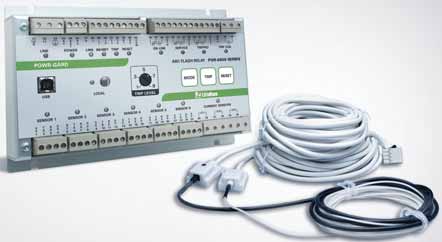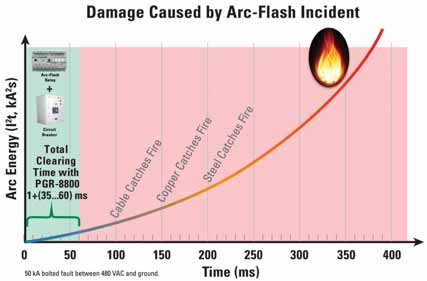Unfortunately, not enough attention has
been paid to arc-flash hazards in mining,
and even the regulatory agencies have
not yet fully responded to the danger.
This article discusses what an arc flash
is, what causes it, and some of the meas-ures that can be taken to reduce the dan-gers of arc flash in aboveground and
underground mining operations.
An arc flash can occur when an ener-gized phase conductor is exposed to
another phase or ground conductor, with
enough voltage differential to overcome
the resistance of the air gap between the
conductors. An arc flash also can occur if
the resistance of the air gap is lowered,
such as when contaminated by dust or
moisture. When this happens, the air in
the gap becomes plasma consisting of
ionized air and vaporized metal.
An arc flash releases large amounts
of energy that can kill or severely injure
anyone exposed (See p. 42). It produces
temperatures up to 35,000°F (hotter
than the surface of the sun) that can
expose a person nearby to heat loads of
120 cal/cm
2
or more—sufficient to char
skin and set clothing on fire. It can pro-duce a blast wave with pressures up to
2,000 lb/ft
2
(enough to throw a person
across a room or collapse lungs), eject
bits of molten metal and other debris at
ballistic speeds, and produce a sound
level of 140 dB (equivalent to a gunshot)
or more. The vaporized metal quickly
turns into a cloud of hot metallic oxides,
which can burn themselves into nearby
insulators.
According to the NIOSH Office of
Mine Safety and Health Research, arc-flash burns are the leading cause of non-fatal electrical injuries, accounting for
35% of lost work days due to electrical
injuries in mining between 1990 and
2001
1
, averaging 21 lost work days per
incident and accounting for more than
12,000 lost work days during the 11-year
period of the study.
Most of the injury due to an arc flash
is caused by the infrared radiation it pro-duces. This is measured in terms of the
energy that reaches the person exposed
to it, in calories per square centimeter.
Table 1 shows the effect of various levels
of incident energy.
An arc flash also generates smoke and
toxic fumes from vaporized copper and
other materials—fumes that cause health
problem by themselves. And while these
should eventually be removed by the
mine’s ventilation system, if the arc flash
takes out a substation there’s a chance it
will disable the ventilation system at the
same time.
Arc flash is possible on any system
with voltages of 480 volts or more. In
general, it involves exposing a live con-ductor to either another phase or ground.
Such exposure could be caused by cable
or equipment damage, a misplaced volt-meter probe, improper installation,
dropped tools or even the accumulation
of conductive dust on insulators. It is
worth noting that in a typical mining
electrical distribution system, a neutral-grounding resistor is used to limit
ground-fault current, and as such will
prevent an arc flash from occurring on a
phase-to-ground fault.
While some industries have strict reg-ulations concerning arc-flash hazards,
others do not. In manufacturing and gen-eral industry, for example, OSHA requires
compliance with NFPA 70E, Standard for
Electrical Safety in the Workplace , but
these regulations do not apply in mining.
Instead, MSHA requires compliance with
CFR 30 56 subpart K (Electricity), but
does not specifically cover arc flash. Yet,
for obvious reasons, mine operators must
protect against arc flash, and following
NFPA 70E is a good way to ensure safe-ty. NFPA 70E applies to all electrical
installations in the mining industry
except in underground mines, for self-propelled mobile surface mining machin-ery and trailing cables. Even in those
areas not required by law to comply with
NFPA 70E, MSHA strongly recommends
following its precautions.
Protecting Against Arc Flash
Protection against arc-flash dangers can
be approached from two directions: pro-tect the people and minimize the possi-bility and effects of the arc flash itself.
Protecting the people involves normal
safety precautions and, importantly, the
use of personal protective equipment
(PPE) required by NFPA 70E, including
such things as flame-resistant clothing/
undergarments, flash suits, flash suit
hoods, arc-rated gloves and more.
Limiting arc energy—While protecting
personnel from arc flash with PPE is both
appropriate and necessary, the problem
should be approached from the other
side as well: minimize the danger of arc
flash by eliminating the chance of having
one in the first place, or at least mini-mizing the amount of energy released.
 Table 1: Effect of arc-flash radiation.
Table 1: Effect of arc-flash radiation.
 Table 2: Typical opening times of overcurrent protective devices
Table 2: Typical opening times of overcurrent protective devices.
The energy released in an arc flash is
determined by the square of the current
flow and the duration of the arc (I²t) in
ampere squared seconds, so limiting
either the current or duration of an arc
will limit the damage it can do. One way
to do this is with fast-acting circuit
breakers or current-limiting fuses in the
feed to a panel. These overcurrent pro-tective devices react quickly to limit the
duration of an arc.
Under short-circuit conditions (a 20x
overcurrent condition) a current-limiting
fuse can clear a fault in less than half an
AC cycle (8.3 ms), as shown in Figure 1.
The gray area shows the energy allowed
through by a conventional overcurrent
protective device, while the green area
shows the energy allowed through by a
current-limiting one. An arc does not
draw as much current as a bolted fault,
but even with an 8x overcurrent a cur-rent-limiting fuse can open between 0.1
and 1 second, and some current-limiting
circuit breakers in less than 10 msec.
Table 2 compares the clearing times of
some available overcurrent protective
devices Note that current-limiting fuses
operate more quickly than current-limit-ing circuit breakers and are thus more
effectively limit delivered I²t.
Arc-flash relays— While current-limit-ing fuses and circuit breakers can help
reduce arc-flash energy, they have a sig-nificant drawback; because the earliest
moments of an arc flash may draw only a
fraction of the current of a short circuit,
overcurrent protective devices cannot
distinguish them from a typical inrush
current, and must wait until the current
increases—during which time significant
harm can be done to nearby personnel. If
the current is low enough, an arc can
develop and remain fairly stable for some
time—seconds or longer—before it draws
enough current to trip the overcurrent
protective device.
In contrast, an arc-flash relay (Figure
2) uses light sensors (either point type or
distributed fiber optic type) to detect light
from an emerging arc flash and send a
signal to the relay. The relay will then
send a signal to the trip coil on the break-er feeding the panel. The arc-flash relay is
designed to operate extremely quickly.
The relay and sensors can be used
in transformer enclosures, substations,
switchgear and motor control centers. Arc-flash relays are compact and can easily fit
in retrofit projects and new switchgear with
little or no re-configuration.
 Figure 1: Current limitation with a current limiting fuse.
Figure 1: Current limitation with a current limiting fuse.
 Figure 2: An arc-flash relay.
Figure 2: An arc-flash relay.
 Figure 3: Damage caused by arc-flash incident.
Figure 3: Damage caused by arc-flash incident.
Typically, the light sensors are set to
detect light at 10,000 lux (equivalent to about 10% of the smallest arc). In some
relays the lux tripping level can be user-adjusted to prevent nuisance tripping.
Certain arc-flash relays can be equipped
with current transformers on each phase.
If high levels of light are detected (such
as from opening a panel in direct sun-light or from a nearby arc welder), but no
corresponding increase in current is
detected, then the unit does not trip.
Enough sensors should be used to
cover the application thoroughly, and
they are typically placed near vertical and
horizontal bus bars. In addition to point
sensors, most relays also accept input
from a fiber optic cable that will detect a
flash of light anywhere along its length.
Such cables range from 26 to 65 ft (8 to
20 m) long, and in some cases they can
interconnect to make even longer
lengths. Use long lengths with caution,
however, because the fiber optic cable
may attenuate the light arriving at the
detector end, delaying detection.
Figure 3 shows how damage from an
arc flash increases with time. Clearly, the
faster an arc is detected, the better.
Among the arc-flash relays on the mar-ket, detection times vary from less than 1
ms to about 9 ms. These reaction times
are a function of the relay’s light sensor
input sampling scheme and the design of
its trip output circuit. For example, the
relay’s microprocessor’s sampling rate of
six light sensors might be one sample
every 125 microseconds (8 kHz). The
relay’s microprocessor may be pro-grammed to count three samples above
the threshold value before tripping. The
electronic output takes time to turn on,
say 200 microseconds for an insulated
gate bipolar transistor. Add these times
together and the total detection time in
this example is <1 ms. Typically the
breaker will take an additional 30-35 ms
to open after it receives the trip signal.
An arc-flash relay requires that the
main breaker have a relay trip coil, so in
some cases it may be necessary to replace
the main breaker when the relay is
installed. In addition, the main breaker
should receive regular maintenance—
generally by cycling it off and on every six
to 12 months—to help keep the mecha-nism from seizing up. Some arc-flash
relays have a circuit-breaker fail function;
if the breaker does not trip after a time
delay of 50 to 150 milliseconds and the
arc flash condition is still present, the
unit will trip the upstream supply breaker.
Reliability is essential. Select an arc-flash relay that offers a redundant trip fea-ture that will still be able to trip the break-er if the microprocessor does not. Any fail-ure in the primary path will activate a solid-state shunt-trip relay if a sensor input is
above threshold. This feature is also useful
upon startup after power has been off (as
happens after a planned maintenance shut
down) since a microprocessor requires start
up time before it starts scanning sensors.
In contrast, a solid-state device can detect
an arc and trip in as few as 2 ms.
To further improve reliability, most arc-flash relays have some degree of internal
health monitoring, but designs vary con-siderably. Ideally, the relay will check the
health of each component in the path from
the light sensor to the trip output contact.
The relay should keep event logs that can
be accessed by maintenance personnel.
Several arc-flash relays allow multiple
relays to be connected. This can be useful if the motor control center does not
have a local circuit breaker. In case of an
arc flash, the relay that detected the fault
can send the trip signal to a relay locat-ed in the switchgear upstream. A network
of relays also makes it possible to divide
protection in zones. For these applica-tions most relays come with easy-to-use
configuration software.
Arc flashes are dangerous events; they
can kill or injure people, and damage or
destroy equipment. In an underground
mine, they can start fires that could even-tually fill the mine with hazardous fumes
and trigger secondary explosions. Through
the application of arc-flash relays, it’s pos-sible to contain arc flashes inside cabinets,
minimize the potential for injury, safeguard
equipment, and avoid MSHA fines.





